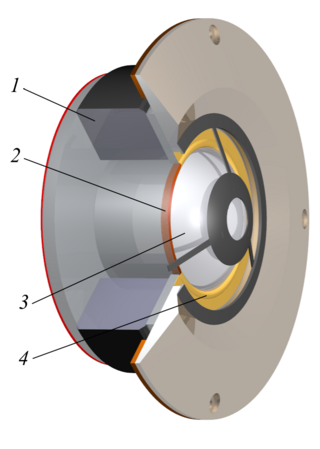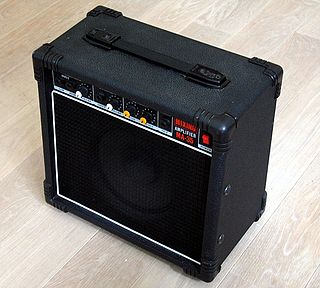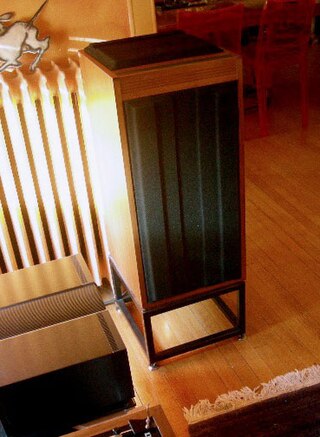Related Research Articles

A loudspeaker is an electroacoustic transducer that converts an electrical audio signal into a corresponding sound. A speaker system, also often simply referred to as a "speaker" or "loudspeaker", comprises one or more such speaker drivers, an enclosure, and electrical connections possibly including a crossover network. The speaker driver can be viewed as a linear motor attached to a diaphragm which couples that motor's movement to motion of air, that is, sound. An audio signal, typically from a microphone, recording, or radio broadcast, is amplified electronically to a power level capable of driving that motor in order to reproduce the sound corresponding to the original unamplified electronic signal. This is thus the opposite function to the microphone; indeed the dynamic speaker driver, by far the most common type, is a linear motor in the same basic configuration as the dynamic microphone which uses such a motor in reverse, as a generator.

Audio crossovers are a type of electronic filter circuitry that splits an audio signal into two or more frequency ranges, so that the signals can be sent to loudspeaker drivers that are designed to operate within different frequency ranges. The crossover filters can be either active or passive. They are often described as two-way or three-way, which indicate, respectively, that the crossover splits a given signal into two frequency ranges or three frequency ranges. Crossovers are used in loudspeaker cabinets, power amplifiers in consumer electronics and pro audio and musical instrument amplifier products. For the latter two markets, crossovers are used in bass amplifiers, keyboard amplifiers, bass and keyboard speaker enclosures and sound reinforcement system equipment.

A tweeter or treble speaker is a special type of loudspeaker that is designed to produce high audio frequencies, typically deliver high frequencies up to 100 kHz. The name is derived from the high pitched sounds made by some birds (tweets), especially in contrast to the low woofs made by many dogs, after which low-frequency drivers are named (woofers).
Roksan is a British manufacturer of high fidelity audio products for domestic use, based in Rayleigh, Essex. It is best known for its influential and innovative design for hi-fi equipment, and in particular its Xerxes platform for playing LP records.

Rudolph Thomas Bozak (1910–1982) was an audio electronics and acoustics designer and engineer in the field of sound reproduction. His parents were Bohemian Czech immigrants; Rudy was born in Uniontown, Pennsylvania. Bozak studied at Milwaukee School of Engineering; in 1981, the school awarded him an honorary doctorate in engineering. Bozak married Lillian Gilleski; the two had three daughters: Lillian, Mary and Barbara.

Acoustic Research was a Cambridge, Massachusetts-based company that manufactured high-end audio equipment. The brand is now owned by VOXX. Acoustic Research was known for the AR-3 series of speaker systems, which used the 12 in (300 mm) acoustic suspension woofer of the AR-1 with newly designed dome mid-range speaker and high-frequency drivers. AR's line of acoustic suspension speakers were the first loudspeakers with relatively flat response, extended bass, wide dispersion, small size, and reasonable cost.
Sonos, Inc. is an American developer and manufacturer of audio products best known for its multi-room audio products. The company was founded in 2002 by John MacFarlane, Craig Shelburne, Tom Cullen, and Trung Mai. Patrick Spence has been its CEO since 2017.

Bi-amping and tri-amping is the practice of using two or three audio amplifiers to amplify different audio frequency ranges, with the amplified signals being routed to different speaker drivers, such as woofers, subwoofers and tweeters. Biamping can be done with a single power amplifier if the device has more than one amplifier, as the case with a stereo power amp. Triamping cannot be done with a stereo power amp; a mono power amp would need to be added or a home theatre receiver could be used. With bi-amping and tri-amping, an audio crossover is used to divide a sound signal into different frequency ranges, each of which is then separately amplified and routed to separate loudspeaker drivers. In some bass amplifiers using bi-amping, the woofer and horn-loaded tweeter are in the same speaker enclosure. In some bi-amp set-ups, the drivers are in separate speaker enclosures, such as with home stereos that contain two speakers and a separate subwoofer.
Phonocar is an Italian Company, founded in Reggio Emilia, Italy, in 1972. Phonocar started with the production of wooden car-radio consoles and gradually specialized in car hi-fi speakers, amplifiers, audio-video equipment, security systems and related accessories. Phonocar products are distributed under her trademarks Phonocar, Sec, Mlife and Galileo.

AirPlay is a proprietary wireless communication protocol stack/suite developed by Apple Inc. that allows streaming between devices of audio, video, device screens, and photos, together with related metadata. Originally implemented only in Apple's software and devices, it was called AirTunes and used for audio only. Apple has since licensed the AirPlay protocol stack as a third-party software component technology to manufacturers that build products compatible with Apple's devices.
The Wharfedale MACH series of loudspeakers consists of the MACH 3, 5, 7, and 9. This is an informational page devoted to owners and users of these loudspeakers and those interested in history and construction of electronic sound reproduction.

Nexus Q is a digital media player developed by Google. Unveiled at the Google I/O developers' conference on June 27, 2012, the device was expected to be released to the public in the United States shortly thereafter for US$300. The Nexus Q was designed to leverage Google's online media offerings, such as Google Play Music, Google Play Movies & TV, and YouTube, to provide a "shared" experience. Users could stream content from the supported services to a connected television, or speakers connected to an integrated amplifier, using their Android device and the services' respective apps as a remote control for queueing content and controlling playback.

A keyboard amplifier is a powered electronic amplifier and loudspeaker in a wooden speaker cabinet used for amplification of electronic keyboard instruments. Keyboard amplifiers are distinct from other types of amplification systems such as guitar amplifiers due to the particular challenges associated with making keyboards sound louder on stage; namely, to provide solid low-frequency sound reproduction for the deep basslines which keyboards can play and crisp high-frequency sound for the high-register notes. Another difference between keyboard amplifiers and guitar/bass amplifiers is that keyboard amps are usually designed with a relatively flat frequency response and low distortion. In contrast, many guitar and bass amp designers purposely make their amplifiers modify the frequency response, typically to "roll off" very high frequencies, and most rock and blues guitar amps, and since the 1980s and 1990s, even many bass amps are designed to add distortion or overdrive to the instrument tone.
The following is a list of on-demand music streaming services. These services offer streaming of full-length content via the Internet as a part of their service, without the listener necessarily having to purchase a file for download. This type of service is somewhat similar to Internet radio. Many of these sites have advertising and offer non-free options in the style of a digital music store.

The Linn Isobarik, nicknamed "Bariks" or "Briks", is a loudspeaker designed and manufactured by Linn Products. The Isobarik is known for both its reproduction of low bass frequencies and being very demanding on amplifiers.

Sonos Studio is an art gallery and studio established on May 9, 2012, and owned by American consumer electronics company Sonos. Located in Los Angeles, United States, the studio has also had temporary pop-up locations in New York City, London, and Amsterdam.

The Play:1 is a smart speaker developed by Sonos, announced and released on October 14, 2013, as the fourth and least expensive product in the Play line of speakers. It is one of the compatible speakers that can also link in SonosNet, a mesh network that can interlink speakers to play media for one, some or all speakers regardless of location.

The Play:5 is a smart speaker developed by Sonos, announced on October 13 and released on November 5, 2009, and is the debut product in the Play line of products. It is one of the compatible speakers designed to initiate SonosNet, stereo pair with itself and pair additionally with the Playbar and SUB to initiate a basic home theater system.

The Sonos One is a smart speaker developed by Sonos, announced on October 4, 2017 and released on October 24. The speaker contains a six-microphone array, allowing use of the virtual assistants, Amazon Alexa and Google Assistant. In 2018, the smart speaker added support for Apple's AirPlay 2.

Invoke is a smart speaker developed by Harman Kardon and was powered by Microsoft's intelligent personal assistant, Cortana. Voice interaction with Cortana provides features such as setting alarms, facts, searches, weather, news, traffic, flights, and other real-time information. Additionally, the speaker's Cortana integration with one's Microsoft Account enabled calendars, reminders, commutes, to-do lists, and home automation features, among others.
References
- 1 2 3 4 "PLAY:3 — Mid-size with Stereo Sound". Sonos . Retrieved 3 November 2016.
- ↑ "Sonos PLAY:3 All-in-One Music Streaming Speaker - Wireless - Single - Black" . Retrieved 3 November 2016.
- 1 2 "Sonos Confirms Apple AirPlay 2 Support, Discontinues the Play:3". Wifi Hifi Magazine. 2018-04-26. Retrieved 2018-12-28.
- 1 2 "Introducing the PLAY:3". Sonos Blog. Sonos. 20 July 2011. Archived from the original on 6 November 2016. Retrieved 2 November 2016.
- ↑ "Spotify now available for streaming in every room of the home on Sonos". Sonos. 14 July 2011. Archived from the original on 2 October 2015. Retrieved 31 October 2016.
- ↑ "Sonos and Mog team up to bring high-quality listening experience to the home". Sonos. 24 May 2011. Archived from the original on 2 October 2015. Retrieved 31 October 2016.
- ↑ "Missing: An Interactive Installation by The xx at Sonos Studio". YouTube. 28 November 2012. Retrieved 1 November 2016.
- ↑ "Sonos and SOFTlab light up the Sonos Studio". Sonos . 18 July 2013. Archived from the original on 4 November 2016. Retrieved 1 November 2016.
- ↑ "Noah And The Whale Cinema Screening With Sonos". Sonos Blog. Sonos. 16 May 2013. Retrieved 3 November 2016.[ permanent dead link ]
- ↑ "8tracks + Sonos = House Party". Sonos Blog. Sonos. 11 July 2013. Archived from the original on 7 October 2016. Retrieved 3 November 2016.
- ↑ Mellor, Chris (2 September 2014). "Sonos burns its Bridges: Our home-grown Wi-Fi mesh will do". The Register. Retrieved 2 November 2016.
- ↑ "Introducing an Even Simpler Sonos". Sonos Blog. Sonos. 2 September 2014. Archived from the original on 20 September 2016. Retrieved 3 November 2016.
- ↑ "Trueplay Speaker Tuning Is Here". Sonos Blog. Sonos. 10 November 2015. Archived from the original on 20 October 2016. Retrieved 3 November 2016.
- ↑ Dedezade, Esat (1 November 2016). "Drop everything and download: Spotify Connect for Sonos". Stuff. Retrieved 3 November 2016– via Haymarket Media Group.
- ↑ Costa, Christian (31 May 2015). "Sonos Play:1 Review". GadgetReview. Retrieved 2 November 2016.
- ↑ Lazar, Lonnie (9 November 2011). "Thirty Days With Sonos Play 3: A Letter From Music Heaven [Review]". Cult of Mac. Retrieved 3 November 2016.
- ↑ "Setting up surround sound with the Sonos PLAYBAR". Sonos . Retrieved 3 November 2016.[ permanent dead link ]
- ↑ "Sonos Explained: The Basics of Setup". Sonos . Retrieved 3 November 2016.
- ↑ "Trueplay Speaker Tuning Software". Sonos . Retrieved 3 November 2016.
- ↑ Gordon, Michael (14 October 2013). "Sonos presents Play:1, a pint-sized wireless streaming speaker for $199". Engadget . Retrieved 2 November 2016– via AOL.
- ↑ "PLAY:5 — Biggest and Boldest". Sonos . Retrieved 3 November 2016.
- 1 2 O'Brien, Terrence (1 August 2011). "Sonos Play:3 review". Engadget . Retrieved 3 November 2016– via AOL.
- ↑ "Sonos Play:3 Teardown - iFixit". www.ifixit.com. 26 February 2013. Retrieved 3 November 2016.
- ↑ Arthur, Charles (15 September 2011). "Sonos PLAY:3 – review". The Guardian . Retrieved 3 November 2016.
- ↑ Solomon, Kate (29 July 2011). "Sonos Play:3 review". TechRadar . Retrieved 3 November 2016– via Future plc.
- ↑ Gardiner, Bryan (28 January 2013). "Review: Sonos Play:3 Wireless Speaker". Wired . Retrieved 3 November 2016– via Condé Nast.